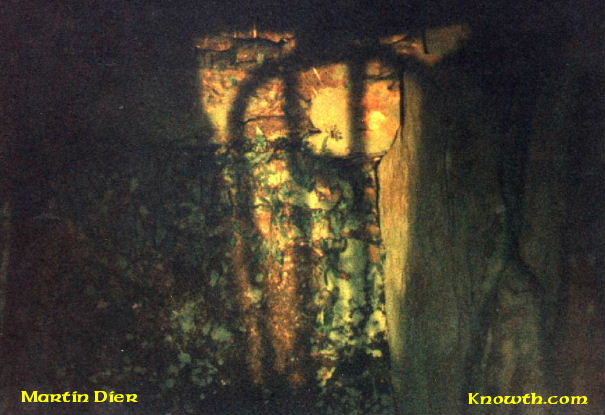Tlachtga - Hill of Ward
Tlachtga (Hill of Ward) near Athboy, Co Meath is 12 miles from the Hill of Tara. The earthworks which are about 150 metres in diameter are most impressive from the air. Tlachtga dates from approximately 200 AD and was the location of the Great Fire Festival begun on the eve of Samhain (eve of the 1st November).
The festival probably lasted for least several days and centred on the god Lugh. The site takes it name from Tlachtga the daughter of the Druid Mug Ruith who died there giving birth to triplets. Tlachtga is clearly visible from Tara and the fire lit on the eve of Samhain was a prelude to the Samhain Festival at Tara.
With the coming of Christianity the festival was incorporated into the Christian calendar as a time of remembrance for the holy souls, so the Samhain festival of the ancestors retained its relevance. The customs of Samhain that didn't fit into Christianity survived as Halloween. Irish immigrants carried the Halloween tradition to North America in the 19th century.
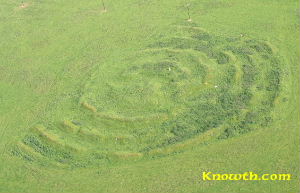 The Festival of Samhain was the great festival of the dead. It also marked
the beginning of the Celtic New Year. The Winter fires were lighted when
the sun went down on the eve of Samhain.
The Festival of Samhain was the great festival of the dead. It also marked
the beginning of the Celtic New Year. The Winter fires were lighted when
the sun went down on the eve of Samhain.
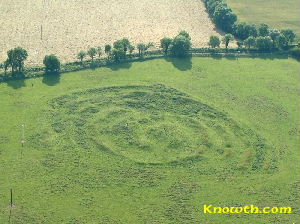 The earthworks seen on the Hill of Ward today represent the last phase of
development about 2000 years ago. The remains of an older barrow burial
have been incorporated in the earthworks. It is likely that the hill
was the centre of ritual activity long before the Celtic period.
The earthworks seen on the Hill of Ward today represent the last phase of
development about 2000 years ago. The remains of an older barrow burial
have been incorporated in the earthworks. It is likely that the hill
was the centre of ritual activity long before the Celtic period.
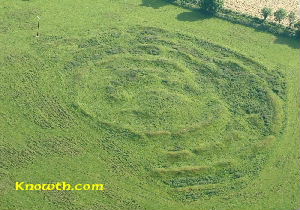 Loughcrew is clearly visible from Tlachtga,
the cairns at Loughcrew are about 5000 years old. At Cairn L the Samhain
sunrise illuminates a standing stone in the chamber of the cairn.
Loughcrew is clearly visible from Tlachtga,
the cairns at Loughcrew are about 5000 years old. At Cairn L the Samhain
sunrise illuminates a standing stone in the chamber of the cairn.
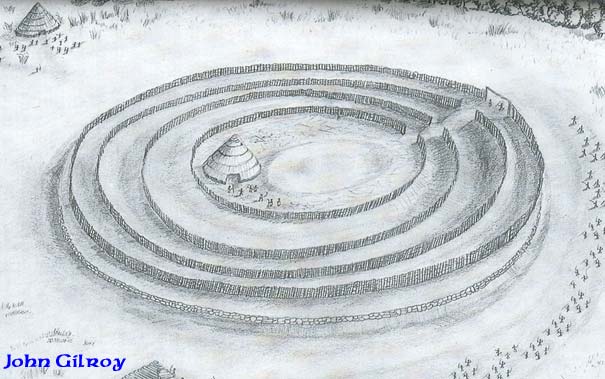
How Tlachtga may have looked in Celtic times from John Gilroy's book
Tlachtga: Celtic Fire Festival.
Tara is also clearly visible from Tlachtga and Tara is also associated with the celebration of Samhain. The Stone Age Mound of the Hostages is also aligned with the Samhain sun rise. The following image was photographed by Martin Dier, it shows the sunbeam illuminating the back of the chamber. The illumination is impaired by the modern gate at the entrance of the passage.
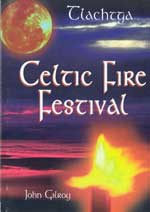 Tlachtga: Celtic Fire Festival by
John Gilroy.
Tlachtga: Celtic Fire Festival by
John Gilroy.Tlachtga was the centre of the Great Fire Festival that signalled the onset of winter. The rituals and ceremonies carried out here by the pre-Christian Irish, offered assurances to the people that the powers of darkness would be overcome, and the powers of light and life would, once again, be in the ascendancy. This was the place where the Celtic sungod was celebrated at the year's end. More ...
Boyne Valley Private Day Tour
 Immerse yourself in the rich heritage and culture of the Boyne Valley with our full-day private tours.
Visit Newgrange World Heritage site, explore the Hill of Slane, where Saint Patrick famously lit the Paschal fire.
Discover the Hill of Tara, the ancient seat of power for the High Kings of Ireland.
Book Now
Immerse yourself in the rich heritage and culture of the Boyne Valley with our full-day private tours.
Visit Newgrange World Heritage site, explore the Hill of Slane, where Saint Patrick famously lit the Paschal fire.
Discover the Hill of Tara, the ancient seat of power for the High Kings of Ireland.
Book Now
Home
| Newgrange
| Knowth
| Dowth
| Hill of Tara
| Fourknocks
| Loughcrew
| More Places
| Labyrinths
| Local Info
| Art Works
| Articles
| Images
| Books
| Links
| Boyne Valley Tours
| Contact


